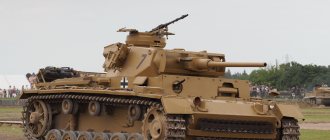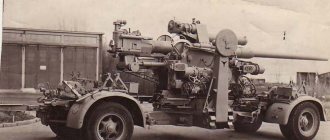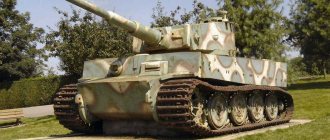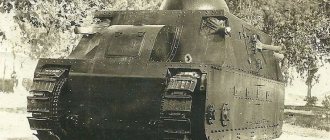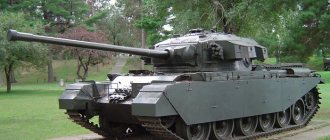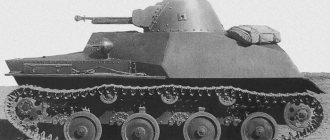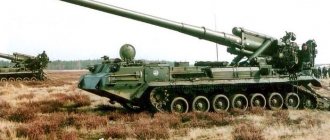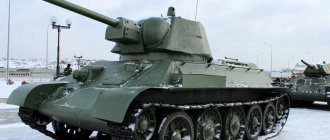KV-1. Multi-ton ghost
The concept of a heavy breakthrough tank was created back in the thirties, but most designers still dreamed of multi-turret monsters capable of hitting the enemy with several cannons and machine guns. However, in reality, the idea of a heavy single-turret tank was also realized, designed to storm long-term enemy fortifications and having projectile-proof armor, rather than bulletproof armor, which was used to protect most tanks of that time.
The KV-1 tank became the world's first production tank with anti-ballistic armor. During the Soviet-Finnish War, it turned out that the KV-1 turned out to be much more convenient than its multi-turreted counterparts, because it could be more protected with the same weight. Therefore, it was adopted and mass production began.
Then the Great Patriotic War broke out, in which these steel monsters went to attack the Germans. Suddenly it turned out that most German guns were simply not capable of penetrating the armor of the KV-1, but it destroyed enemy tanks with its 76 mm cannon without any problems. It was then that the Germans nicknamed the Soviet tank the “ghost” because their main anti-tank guns left no marks on it.
An excellent example of the use of the KV-1 in the early stages of the war is the battle at the Voyskovitsa state farm, when Zinoviy Grigorievich Kolobanov destroyed 22 German tanks in his tank, and together with four more KV-1s, a total of 43 enemy tanks were knocked out in that battle.
Having received an order to stop the enemy’s advance, Senior Lieutenant Kolobanov set up an ambush, burying the tank and camouflaging it. Having let the reconnaissance motorcyclists pass, he waited for the tank column to appear, and with several shots he knocked out 3 front and several trailing vehicles, thus locking the entire column on the road, after which he shot the enemies as if in a shooting range.
After the battle, more than a hundred hit marks were counted on Kolobanov’s KV-1, but its armor was never penetrated. But the tank also had disadvantages - a weak chassis, and later it was replaced by the lighter and faster KV-1s.
German heavy tank "Tiger" - a dangerous heavyweight
Before the start of World War II, German tank doctrine did not provide for the use of heavy breakthrough vehicles, therefore, although the development of heavy tanks was carried out, it did not receive much support from the state. After the attack on the USSR, German troops met in battle with the T-34 and KV-1, and it suddenly became clear that these machines, with the proper skill of the crews, could create hell for the entire German army. Therefore, the German heavy tank “Tiger” was urgently created as a counterbalance to these vehicles.
It was equipped with excellent ballistic armor and one of the best tank guns - a converted 88 mm anti-aircraft gun. As a result, the prototype was provided to the command on Hitler’s birthday, and the first tanks went into battle a few months later, in August 1942.
True, the tank turned out to be damp, and only one of the four made it to the first battle; the rest broke down along the way. However, when the problems were eliminated, the Tiger became a serious headache for Soviet tankers, since it could shoot at any of our tanks from a great distance, while remaining invulnerable to almost any attack.
It was the appearance of the Tigers that stimulated work on the creation of the famous Soviet IS-2 tank. Until the end of the war, the German “fortress on tracks,” with skillful management, remained a formidable fighting machine, which was confirmed by the battle at Villers-Bocage, where the famous tank ace Michael Wittmann, with the help of five “Tigers,” stopped the British offensive, destroying 11 enemy tanks and 2 anti-tank guns and 13 armored personnel carriers.
But the tank also had its drawbacks. Firstly, it was the most expensive to produce not only in Germany, but also in the world, but the main problem was its dimensions and tracks, which made it difficult to transport equipment by rail and constantly broke down, and it was almost impossible to repair them in the field. Many broken down Tigers were simply abandoned by the crews during the retreat. Several captured “Tigers” with stars on the towers fought in the Soviet army, however, due to the small number of spare parts, they did not fight much.
"They are for us"
The IS-3 was literally a few months late for World War II. But the tank still showed up in defeated Berlin. September 7, 1945
Article on the topic Operation “Unthinkable-1945”. How the allies were preparing to attack the USSR The allies of the Anti-Hitler coalition - the USSR, the USA, England and France - decided to organize a joint parade. Western countries exhibited light armored vehicles and their fairly new tanks. The British were represented by the cruising A34 Comet, the Americans by the light M24 Chaffee, the French did not have their own armored vehicles at all. At the end of the parade, a “box” of 52 real monsters from the 49th Guards Tank Brigade of the 2nd Guards Tank Army proceeded from the side of the Victory Column towards the Brandenburg Gate.
The appearance of the formidable, squat armored vehicles caused a real shock among the allies, who saw the IS-3 for the first time. These tanks were so superior to everything that was in the arsenals of the United States and Great Britain at that time that an American tankman from the retinue of the commander of the 3rd US Army, General George Patton , literally shuddered. “Calm down,” said the general, “they are on our side for now.”
In Moscow, the new IS-3 tanks were first shown at a parade on May 1, 1946.
IS-3 tanks at the Berlin Victory Parade, September 7, 1945. Photo: Commons.wikimedia.org
SU-152 - hunter of the German menagerie
By the middle of the war, it became clear that the troops lacked a howitzer that could move under its own power, thus being more mobile and supporting tanks and infantry in the attack. Therefore, on the basis of the KV-1s tank, Soviet engineers created the SU-152 self-propelled gun, with a huge 152 mm cannon that could fire both canopy and direct fire.
Along the way, it turned out that this monstrous vehicle copes very well with the heavy Tiger tanks and medium Panther tanks that the Germans recently acquired, and under favorable circumstances it can even compete with the German self-propelled gun Ferdinand (aka Elefant), well the weaker SU-152 tanks were simply turned into a pile of scrap metal.
At the same time, its rather low silhouette allowed it to effectively organize tank ambushes. For its special successes in battles with the German tank menagerie, the SU-152 was nicknamed “St. John’s Wort” by Soviet soldiers. At the same time, the self-propelled gun was often used in the assault on fortified areas or cities, since the shots of its monstrous cannon successfully folded buildings like houses of cards.
And there were countless victories over enemy tanks. Many tank aces of the Soviet troops distinguished themselves while fighting in this vehicle. For example, the crew of Major Sankovsky disabled 10 enemy tanks in one day, receiving two Orders of the Red Banner for this feat.
There were also funny episodes in the combat journey of this vehicle. According to tanker Nikolai Konstantinovich Shishkin, in one of the battles he spotted four German tanks and knocked out three, forcing the last one to retreat. Having approached closer, he discovered to his horror that he had shot at Soviet T-34 tanks, and was already preparing to appear before the tribunal for the destruction of his own. However, then he saw that crosses were painted on the tanks, which meant they were captured thirty-fours captured by the Germans.
The SU-152 performed well in battles, although quite soon its production was stopped, replaced by an even more advanced self-propelled gun based on the IS-2 heavy tank, the ISU-152, which inherited the glorious nickname “St. John’s Wort” from its predecessor.
T-34 (Soviet Union)
This legendary tank was the most popular during the war and the second in production (about 84,000 vehicles). It is also one of the longest-lasting tanks ever produced. To this day, many surviving units are located in Asia and Africa.
The popularity of the T-34 is partly due to its 45 mm sloping frontal armor, which was not penetrated by German shells. It was a fast, maneuverable and durable vehicle that caused serious concern among the German armored forces.
IS-2 "Stalin's Sledgehammer"
The IS-2 is almost the only Soviet tank developed almost entirely during the war; all the others, one way or another, began to be developed before the war or used developments from the 30s. After the appearance of the Tigers and Panthers on the battlefields, it became obvious to the Soviet command that there was an urgent need to create a tank as an equivalent counterweight. This is how the IS-1 appeared first (the name stands for Joseph Stalin), almost immediately followed by the IS-2 or IS-122 (122 is the caliber of the new tank gun).
In order to protect itself from the main enemy tank and anti-tank guns, the “Stalin’s Sledgehammer” was equipped with appropriate armor and a powerful 122 mm cannon, which in initial tests was able to tear off the turret from a captured “Panther”.
The tank entered service at the end of 1943, and at the beginning of 1944 it entered service with the troops. At first, due to this haste, it was unfinished and often broke down, but after detailed study of the problems, it became one of the most unpretentious and repairable tanks of the Soviet army. It happened that damaged IS-2s returned to service literally within a few days, and this distinguished them favorably from the capricious and difficult to repair German machines.
There were, of course, disadvantages - a low rate of fire and an ammunition capacity of only 28 shells. But if the tank hit, it fully justified its nickname.
For example, during the Lvov-Sandomierz operation, two IS-2s from an ambush destroyed 17 German tanks and self-propelled guns in two days, and on the Sandomierz bridgehead, IS-2 tanks knocked out six “Royal Tigers,” the Wehrmacht’s most advanced combat vehicles.
The IS-2 especially distinguished itself during assaults on cities, where, like the SU-152, they were used to destroy buildings captured by the enemy and to support advancing infantry. As of 2007, fifteen IS-2Ms, slightly modified after the war, were still in use as fixed gun emplacements for Cuba's coastal defenses.
Monstrously roaring and spewing fire, steel beasts, children of the Second World War, defended their infantry from other similar predators and tirelessly beat the enemy. Many years have passed since then, tank production has been modernized, but the vehicles described above will forever go down in history as the most powerful titans of their time, created by gloomy geniuses in order to terrify the enemy and “OVERCOME”!
9. "Sherman-Firefly" (UK)
The Sherman Firefly was a British variant of the M4 Sherman, equipped with a devastating 17-pounder anti-tank gun, more powerful than the original 75 mm Sherman gun. The 17-pounder was destructive enough to damage all known tanks of the time. The Sherman Firefly was one of those tanks that terrorized the Axis powers and has been described as one of the deadliest fighting vehicles of World War II. In total, more than 2,000 units were produced.
INTERESTING TOP 10 Products for heart attack prevention
